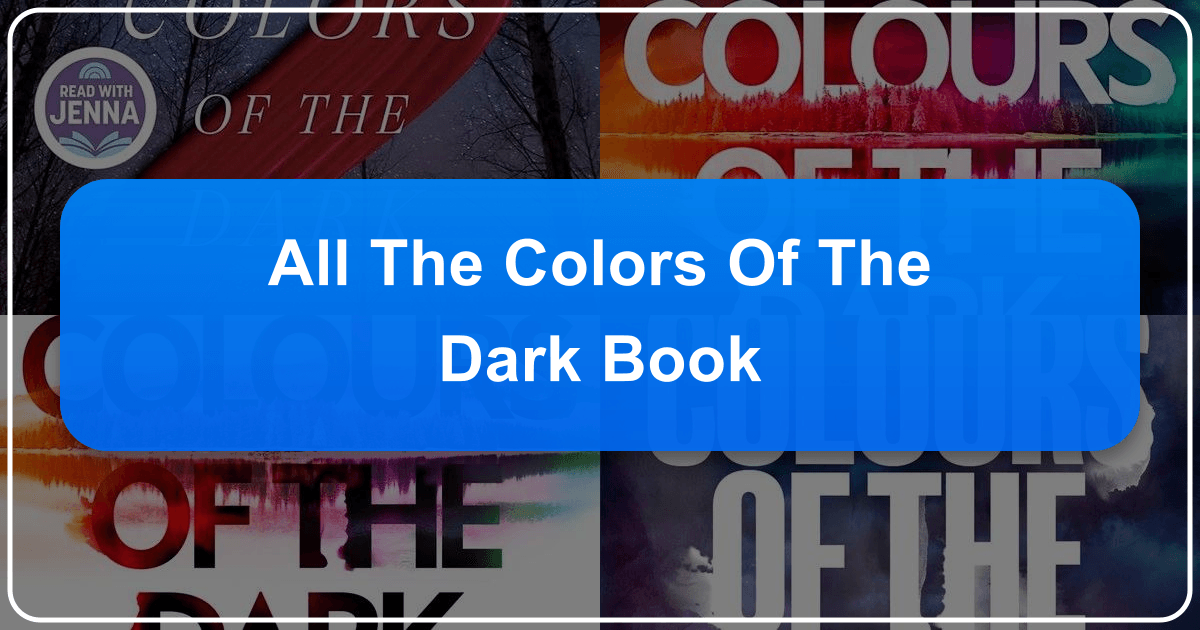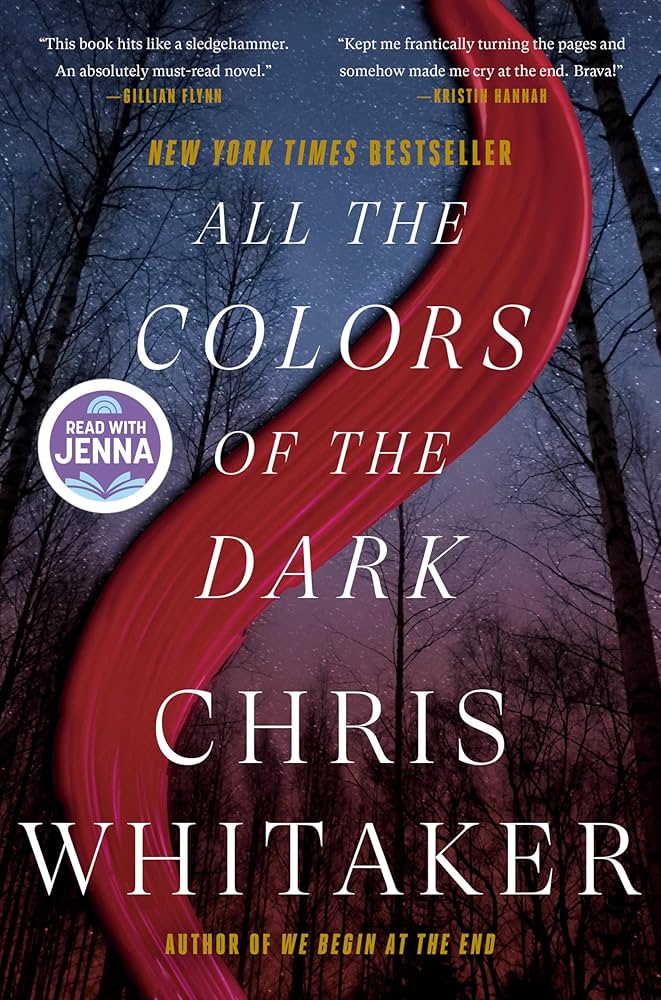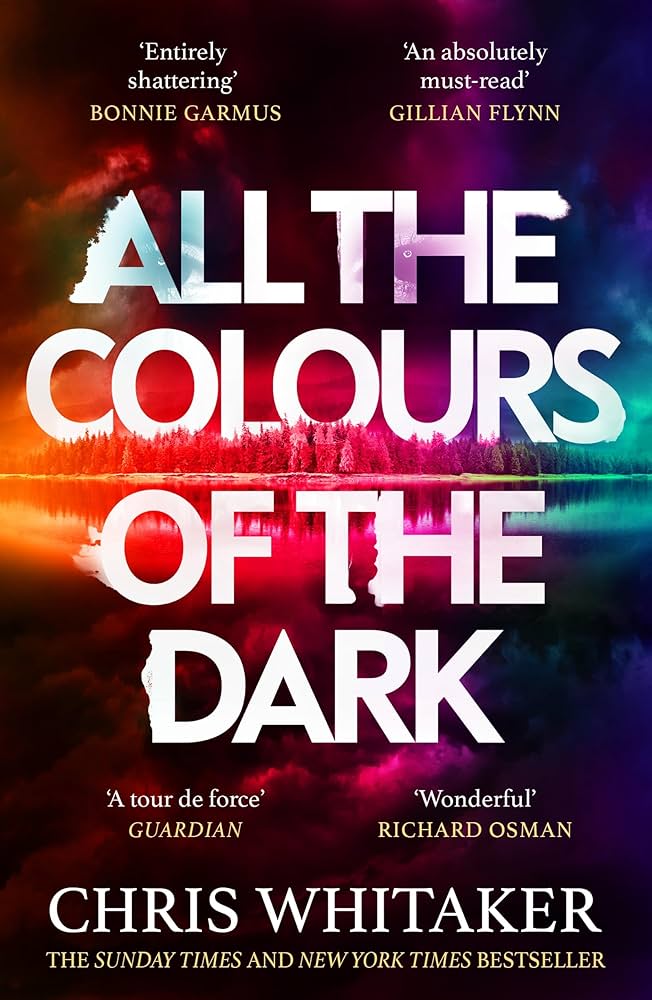All the Colors of the Dark: A Deep Dive into Chris Whitaker's Gripping Novel

Chris Whitaker’s “All the Colors of the Dark” is more than just a thriller; it’s a multi-layered narrative that explores themes of love, loss, obsession, and the enduring power of hope against a backdrop of 1970s America. This in-depth analysis will delve into the novel’s intricate plot, compelling characters, and enduring cultural impact, examining its various facets through the lenses of genre, authorial style, and literary influence.
The Novel’s Genre and Narrative Structure

“All the Colors of the Dark” defies easy categorization, masterfully blending several genres into a unique and captivating whole. At its core, it is a mystery, centered around the disappearance of young girls in the small town of Monta Clare, Missouri. The narrative unfolds as a missing person’s case, gradually escalating into a suspenseful thriller as the investigation intensifies, revealing the chilling presence of a serial killer. However, the novel transcends the conventional thriller format by incorporating elements of a coming-of-age story and a poignant love story, adding layers of emotional depth and complexity.
The narrative structure itself is significant. It’s not a linear progression but rather a tapestry woven from multiple perspectives and timelines. The story jumps between different characters and periods, slowly revealing interconnected events that shape the lives of the protagonists. This non-linear approach keeps the reader engaged, prompting speculation and piecing together the fragmented narrative to unravel the full truth. The shifting timelines, from the initial abduction in the 1970s to the unfolding consequences across subsequent decades, highlight the long-lasting impact of trauma and the enduring nature of both obsession and hope.

The novel’s setting, 1970s America, is more than just a backdrop; it is integral to the narrative. The era’s social and political climate – the waning years of the Vietnam War, the rise of social movements, and a sense of national uncertainty – creates an atmosphere of unease and potential for violence, mirroring the darkness that pervades the small town of Monta Clare. The juxtaposition of this volatile societal atmosphere with the intimate relationships and personal struggles of the characters further enriches the narrative’s complexity.

Subgenres and Thematic Elements
While “All the Colors of the Dark” is primarily a thriller, it also incorporates elements of other subgenres, including:
- Crime Fiction: The investigation into the missing girls forms a strong crime fiction element, exploring police procedure, forensic evidence, and the challenges of solving a complex case.
- Psychological Thriller: The novel delves into the psychological states of the characters, particularly Patch’s obsessive search for Grace, exploring themes of trauma, memory, and the blurring lines between reality and delusion.
- Coming-of-Age Story: The narrative tracks the development of Patch and Saint over decades, charting their growth, their emotional scars, and their evolving relationships.
- Romance: The unique and unconventional love story between Patch and the unseen Grace is an essential emotional driver, adding a layer of hope and emotional resonance to the otherwise dark narrative.
These interwoven subgenres are not merely additive but contribute to the novel’s central themes: the enduring power of love and hope, the lasting impact of trauma, and the complexities of obsession and justice.
Chris Whitaker’s Authorial Style and Craft
Whitaker’s writing style is a key component of the novel’s success. He employs evocative and lyrical prose, painting vivid pictures of the Ozark landscape and creating a palpable sense of atmosphere. His descriptive language is rich and precise, capturing the beauty of the natural world while simultaneously emphasizing the darkness that lurks beneath the surface. The author’s use of imagery is particularly striking; his descriptions are not merely visual but also sensory, drawing the reader into the narrative through all five senses.
Character Development and Narrative Voice
The strength of “All the Colors of the Dark” lies not only in its plot but also in its characters. Whitaker creates compelling and deeply flawed individuals, their past traumas and present struggles shaping their actions and motivations. Patch, the one-eyed boy who becomes an unlikely hero, is a complex character whose obsession with Grace fuels his life’s journey. Saint, his childhood friend, is equally well-developed, exhibiting resilience and determination as she supports Patch’s quest. The supporting characters, from Patch’s mother to the townspeople, are also richly portrayed, adding further depth to the narrative.
Whitaker employs a narrative voice that shifts between characters and perspectives, giving the reader access to the internal thoughts and feelings of different individuals. This approach enhances the novel’s emotional impact, allowing the reader to fully understand the motivations and emotional states of the characters. The shifts in perspective are also a crucial element of the narrative structure, allowing the reader to experience the unfolding mystery from different angles.
Literary Devices and Techniques
Whitaker employs several literary devices and techniques to enhance the narrative’s impact. These include:
- Symbolism: The recurring motif of eye patches, representing Patch’s unique identity and his obscured vision, is a powerful symbol of both his physical difference and his obscured past.
- Foreshadowing: The novel skillfully employs foreshadowing, hinting at future events and creating suspense.
- Flashback: Whitaker uses flashbacks to provide context and develop the characters’ backstories, enriching the understanding of their present actions.
- Irony: The novel effectively utilizes irony to highlight the disparities between appearance and reality, hope and despair, and the unpredictability of life.
The use of these techniques, combined with Whitaker’s evocative prose and skillful character development, contributes to the immersive reading experience.
The Cultural Impact and Literary Influence of “All the Colors of the Dark”
Upon its release, “All the Colors of the Dark” received widespread critical acclaim and commercial success, solidifying Whitaker’s reputation as a significant voice in contemporary literature. The novel’s unique blend of genres, its compelling characters, and its exploration of universal themes resonated deeply with readers and critics alike.
Awards and Recognition
The novel’s success is evident in the numerous accolades it received, including:
- [List specific awards and nominations received by the book]
These awards demonstrate the book’s quality and its impact on the literary landscape.
Literary Influence and Comparisons
“All the Colors of the Dark” has been compared to works by other authors, including:
- [List specific authors and works the novel has been compared to, and explain the similarities and differences.]
These comparisons highlight the novel’s unique place within the broader landscape of contemporary literature. The comparisons also indicate its ability to draw parallels with established works while simultaneously carving its own distinctive path.
Adaptations and Future Projects
The success of “All the Colors of the Dark” has also led to interest in adaptations for other media. Currently, plans are underway for:
- [Mention any film or television adaptations or other planned projects.]
These planned adaptations demonstrate the novel’s potential for broader reach and ongoing cultural impact beyond the literary sphere. The adaptation process itself will undoubtedly spark further discussion and interpretation of Whitaker’s work.
Conclusion: Enduring Themes and Literary Significance
“All the Colors of the Dark” is a significant work of contemporary literature, a testament to Chris Whitaker’s ability to weave together multiple genres and explore complex themes with masterful skill. The novel’s enduring power lies in its exploration of universal themes – love, loss, obsession, and hope – experienced through deeply flawed yet compelling characters against the backdrop of a specific historical and social context. The non-linear narrative structure, evocative prose, and skillful use of literary devices all contribute to its immersive and unforgettable reading experience. Its awards, critical acclaim, and potential for adaptation further underscore its enduring impact on literature and popular culture. Whitaker’s work serves as a powerful reminder of the capacity of storytelling to transcend genre conventions and resonate deeply with readers on a human level.